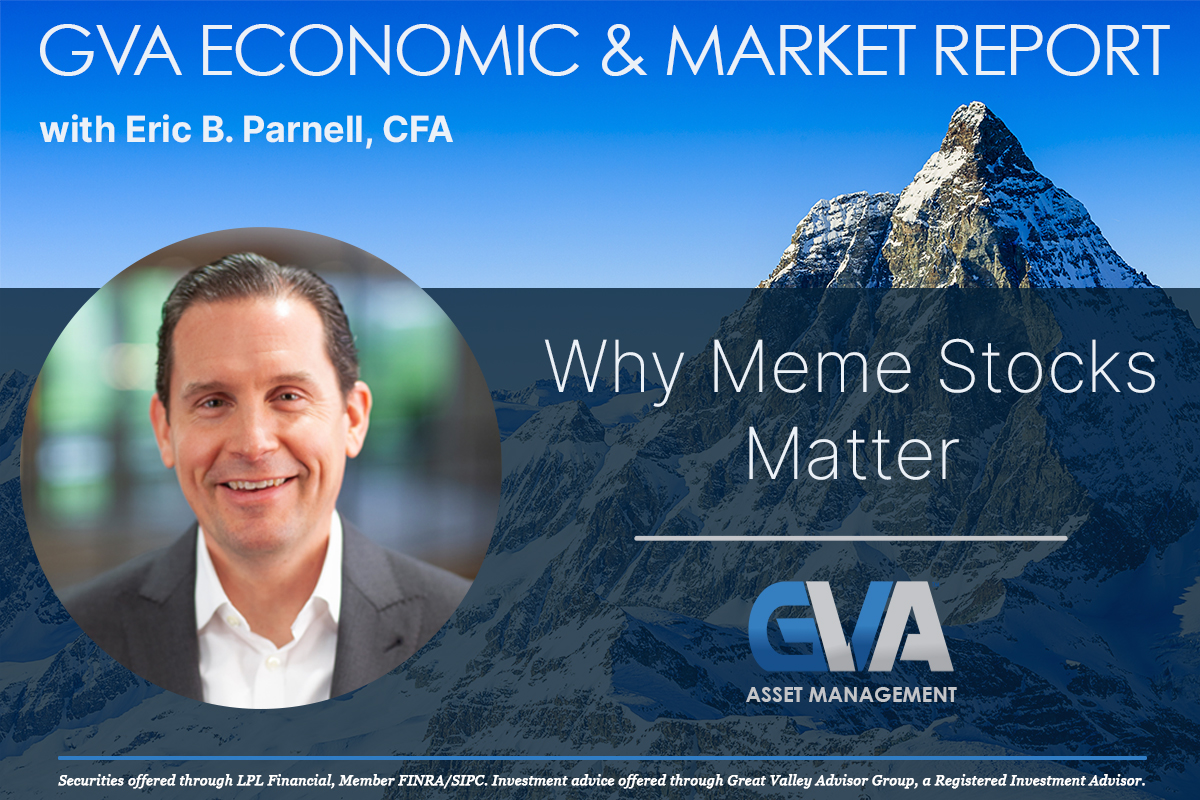
It seems like a frivolous stock market novelty. Companies like GameStop and AMC Entertainment with their relatively small market caps and even more meager sales in the context of the overall marketplace suddenly found themselves returning to the financial news spotlight. This came thanks to recent pops in their stock prices that were less fundamentally based and more reminiscent of the meme stock craze from a few years ago that descended on capital markets in the aftermath of the COVID crisis. While many investors might dismiss the recent spikes in these stocks as nothing more than a humorous side show, they actually send an important signal about broader capital markets today.
What do you meme? So what exactly happened with GameStop and AMC Entertainment recently?
Let’s start with GameStop. After falling to less than $1 per share on a split adjusted basis in late 2020, shares of the gaming retailer skyrocketed more than +12,000% by early 2021 in a short squeeze so epic it was made into a major motion picture. Since that time, GameStop shares had fallen back to earth, declining more than -91% in the more than three years since through this April. But as the calendar flipped to May, GameStop suddenly rediscovered its meme stock verve, spiking more than +500% over the course of two weeks before quickly falling back to earth. No movie sequel is likely, but notable nonetheless.
How about AMC Entertainment. Also languishing in the $1 per share range on a split adjusted basis by the start of 2021, shares of the movie theater company also suddenly soared a somewhat less lusty but still phenomenal +4,000% in the first few months of 2021. In the three years since, AMC shares gave back all of these gains and more, falling more than -99% in total and -80% below its previous 2021 lows before the fun got started that year. But when trading got underway last week, AMC shares suddenly exploded higher by +300% on Monday and Tuesday before quickly returning back lower.
So what? Sure, these are great stories that give investors something to talk with their kids about the markets, but why should we really care from a broader market outlook perspective? We should pay attention to events like the recent meme stock aftershock because they provide us with an indication of the underlying forces at work across capital markets.
Consider when the first meme stock boom took place. It was in late 2020 and early 2021. This was a time following the onset of the COVID crisis where the economy was getting itself back on its feet after shutting down a few quarters earlier. More importantly, it was a time when a torrent of liquidity was pumping into the financial system from all different directions including zero interest rates from the U.S. Federal Reserve and stimulus checks landing in the bank accounts of average American all across the country.
When liquidity is abundant, it is almost always accompanied with widespread anecdotal signs of rampant speculative behavior. This includes the benchmark S&P 500 quickly rebounding to above pre-COVID highs by late 2020 despite an economy still reeling from the pandemic, the price of “assets” like Bitcoin spiking more than +1,600% to levels more than three times their previous bubble highs from late 2017, and stocks on the market periphery like GameStop and AMC Entertainment suddenly dominating the financial news headlines following sudden and phenomenal gains.
How are these outcomes a sign of abundant liquidity? Consider the contrasting period in 2022 into early 2023. During this time, the U.S. Federal Reserve in response to an annual inflation rate fast tracking its way toward double-digits thanks in part to the unintended consequences of the deluge of liquidity injected into the economy in response to the COVID crisis had to sharply reverse course and raise interest rates quickly and aggressively. This included jacking up the fed funds rate by more than five percentage points off of the zero bound. In short, a big plug had been pulled and liquidity was being drained rapidly from the financial system. During this time, the benchmark S&P 500 plunged by -28%, Bitcoin collapsed by nearly -80%, and meme stocks like GameStop and AMC Entertainment were nowhere to be found as investors were instead focused on circling their stock and bond portfolio wagons.
But since the aftermath of the early 2023 coulda been Great Financial Crisis Part II, capital markets have increasingly been exhibiting that same feeling good on liquidity behavior. The S&P 500 is now trading more than +50% above its October 2022 lows and +10% above its previous all-time highs from January 2022. Bitcoin has rebounded nearly +400% from its 2022 bear market lows in reaching new all-time highs. And we have erstwhile meme stocks like GameStop and AMC Entertainment suddenly finding their old form.
The consequences of abundance. It’s a great feeling when capital markets are awash with liquidity. Asset prices rise sharply and shake off downside risks with ease. And the more speculative areas of the market become increasingly rewarding for the more risk tolerant among us. But an abundance of liquidity also comes with the risk not only of the misallocation of capital and speculative excesses, but also the sustained rise of inflation under the right economic conditions. Excess liquidity played a big role in sparking the inflation fires over the last few years, which resulted in the first simultaneous bear market in both stocks and bonds since the stagflationary era of the late 1970s and early 1980s.
Wait a minute! Aren’t we supposed to be in a restrictive monetary policy environment with the fed funds rate north of 5%? Aren’t we still anticipating the U.S. Federal Reserve to start delivering those long anticipated interest rate cuts any FOMC meeting now? Herein lies the excess liquidity rub. For while interest rates may indeed be high, if we are indeed in a market environment where underlying liquidity conditions are still relatively loose, we should not rule out the possibility that inflationary pressures could ultimately start to reignite. If this were to occur, hopes of Fed interest rate cuts could eventually shift to expectations for Fed interest rate hikes. And as 2022 recently showed us, financial markets may not respond well to such a shift in the liquidity tides.
Bottom line. All of the above are not clear and present dangers. While the liquidity environment remains seemingly abundant, inflationary pressures continue to wane amid a strong economic backdrop. If one had to assign a fairy tale to today’s capital markets, the name Goldilocks might come to mind. But a market with copious liquidity comes with the risk that the inflationary bears may soon return home. And the recent meme stock revival is just the latest sign that the liquidity environment may be even more abundant as we continue through a strong 2024 for capital markets.
I/we have no stock, option or similar derivative position in any of the companies mentioned, and no plans to initiate any such positions within the next 72 hours. I wrote this article myself, and it expresses my own opinions. I am not receiving compensation for it. I have no business relationship with any company whose stock is mentioned in this article.
Investment advice offered through Great Valley Advisor Group (GVA), a Registered Investment Advisor. I am solely an investment advisor representative of Great Valley Advisor Group, and not affiliated with LPL Financial. Any opinions or views expressed by me are not those of LPL Financial. This is not intended to be used as tax or legal advice. All performance referenced is historical and is no guarantee of future results. All indices are unmanaged and may not be invested into directly. Please consult a tax or legal professional for specific information and advice.
I/we have no stock, option or similar derivative position in any of the companies mentioned, and no plans to initiate any such positions within the next 72 hours. I wrote this article myself, and it expresses my own opinions. I am not receiving compensation for it. I have no business relationship with any company whose stock is mentioned in this article.
Investment advice offered through Great Valley Advisor Group (GVA), a Registered Investment Advisor. I am solely an investment advisor representative of Great Valley Advisor Group, and not affiliated with LPL Financial. Any opinions or views expressed by me are not those of LPL Financial. This is not intended to be used as tax or legal advice. All performance referenced is historical and is no guarantee of future results. All indices are unmanaged and may not be invested into directly. Please consult a tax or legal professional for specific information and advice.
Compliance Tracking #: 582899-1
